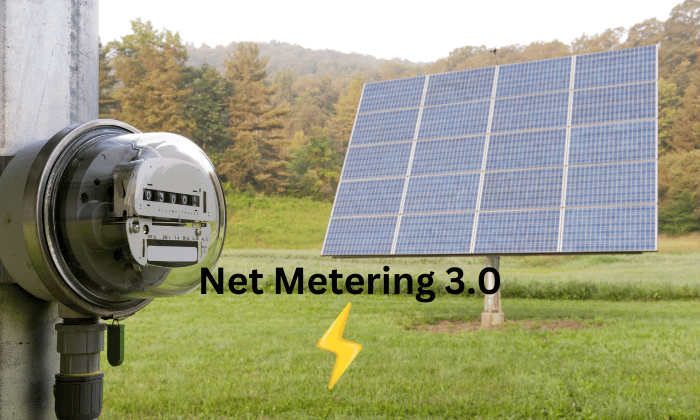What Is Net Metering 3.0
Net Metering 3.0 is the latest iteration of California’s net energy metering policy, designed to address the dynamics of solar energy generation, grid management, and safety concerns. While the previous version, NEM 2.0, was favorable to solar owners, NEM 3.0 introduces changes that can significantly impact the financial incentives of going solar.
When Does Net Metering 3.0 Start In California

NEM 3.0, a revised policy that replaced NEM 2.0 starting on April 13, 2023, was adopted by the California Public Utilities Commission (CPUC) on December 15, 2022.
Net energy metering is a billing system between utility providers and customers who generate their own power through solar or wind. Under this system, self-generators earn credits for the excess electricity their system provides to the grid. NEM 2.0 had a one-to-one offset policy, where the price of supplying a kWh to the grid matched the price of pulling a kWh from the grid. NEM 3.0 will change this pricing structure.
Under NEM 2.0, customers could choose their rate schedule as long as it was time-of-use (TOU). NEM 3.0 will require customers to follow a specific TOU schedule determined by their energy provider, reducing customer choice and making it more restrictive.
Who Does NEM 3.0 Affect?
NEM 3.0 primarily affects utility customers within the service territories of California’s three major investor-owned utilities:
- Pacific Gas & Electric (PG&E)
- Southern California Edison (SCE)
- San Diego Gas & Electric (SDG&E)
- NEM 3.0 Incentive for Battery-Operated Homes
One notable feature of NEM 3.0 is its focus on incentivizing homes equipped with battery storage systems. This incentive arises from concerns about excessive power flowing back into the grid during daytime hours, especially when wildfire risks are high. Homeowners with battery storage systems can expect reduced grid fees compared to those without such systems.
Lower Solar Export Rates
The most significant shift from NEM 2.0 to NEM 3.0 involves changes in solar export rates. Under NEM 3.0, residential solar export rates are determined using an Avoided Cost Calculator, departing from the previous practice of using retail rates. This shift can have a profound impact on the financial benefits of solar energy. The exact export rates vary based on factors like the time of day, day of the week, and month, resulting in a significant reduction in the value of net metering credits, by approximately 75 percent.
The Journey to NEM 3.0
The California Public Utilities Commission (CPUC) approved NEM 3.0 on December 15, 2022, following years of deliberation and negotiations. These changes significantly reduce net metering compensation rates for new solar customers in California.
Key Takeaways from NEM 3.0
- NEM 3.0 drastically reduces the value of solar energy credits, particularly for PG&E, SCE, and SDG&E customers.
- Existing solar customers and those who adopted solar before April 14, 2023, are grandfathered into the previous net metering policies.
- Solar shoppers who applied for interconnection after April 14, 2023, fall under NEM 3.0 and should consider incorporating energy storage for more favorable economics.
- Impact on Solar Savings
- NEM 3.0 has implications for the payback period of solar installations. Factors like increased electricity rates and decreasing solar prices have led to shorter payback periods, making solar more attractive, especially when combined with energy storage.
The Role of Solar Batteries
Under NEM 3.0, solar-plus-storage installations offer faster payback periods than solar-only systems. Storing surplus energy onsite allows homeowners to maximize the value of solar power while reducing what is exported to the utility. This becomes particularly advantageous during peak rate hours.
Grandfather Clause
A limited group of consumers can still qualify for NEM 2.0, provided they submit a complete interconnection application by April 14, 2023. They have until April 15, 2026, to complete the installation and maintain NEM 2.0 status.
Timeline for NEM 3.0 Changes
- December 15, 2022: CPUC officially authorized NEM 3.0.
- April 14, 2023: Deadline for submitting interconnection applications to be grandfathered into NEM 2.0.
- April 14, 2026: Deadline for completing installations to retain NEM 2.0 status.
FAQs
Has NEM 3.0 been approved?
Yes, it was approved on December 15, 2022, and went into effect in April 2023.
Is NEM 3.0 retroactive?
No, it does not retroactively affect existing NEM customers.
Is NEM 2.0 still in effect?
Only for community solar programs; NEM 3.0 replaced NEM 2.0 for others.
Could NEM 3.0 be overturned?
It’s unlikely but possible through legislation or a ballot measure.
What if you buy a house with solar?
You will inherit the net metering rate plan of the previous property owner if you purchased the house after April 14, 2023, and the previous owner was under NEM 1.0 or NEM 2.0.
Is California an ideal location for solar energy adoption?
Absolutely! California stands out as one of the top states in the country for residential solar energy generation, owing to its warm climate, abundant sunshine, and favorable solar incentives.
